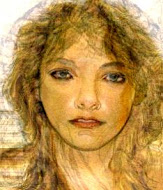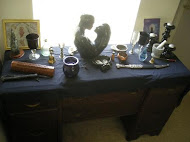Midsummer's Eve or St. John's Eve
Taken in it's entirety from The Element Encyclopedia of Witchcraft by Judika Illes.
Midsummer's Eve was originally intended to coincide with the summer solstice, the day when the Sun enters the sign of Cancer, the astrological sign that belongs to the moon, and Earth's magical forces are at their height. Midsummer's Eve is a major holiday for witches and those who love them. Because fixed calendars came into existence, Midsummer's Eve, especially in its guise as the Feast of John the Baptist, does not necessarily correspond exactly with the solstice. (The solstice moves; the Feast doesn't.) Modern Neo-Pagans, however, frequently coordinate Midsummer's Eve with the solstice and so this festival may be celebrated anytime, depending upon place, traditions, and participants, from approximately June 20 through the 24th. A wild anarchic joyous festival, the ancients would have had no objection to it lingering for three or four days.
Midsummer's Eve is a fire and a water festival characterized by ritual baths and bonfires. Bonfires are built upon carefully selected magical wood with special aromatic herbs thrown into the fires. The ashes are later preserved as amulets. Bonfires are built on the shores of lakes, rivers, streams, and oceans. Just as livestock is driven between or around bonfires, so the were once driven into the sea to be buffeted by spiritually cleansing and magically empowering waves.
Midsummer's marks the convergence of Sun and Moon. The sun is at its zenith but the zodiac has entered the watery sign of Cancer, the only sign ruled by the Moon. Children born during this 30-day period are known as Moon Children. Lunar deities like Artemis, Diana, and Hecate have powerful associations with fire and water as well as botanical magic.
Midsummer's Eve is considered the absolute optimal moment for harvesting magical and medicinal plants. Plants are ideally picked at midnight or when the first dew forms. (Rolling in the dew is believed beneficial for people, too.) Special, unique plants such as the fern seed that provides invisibility are available only on the night. Witch-hunters claimed that this was the night witches rode off to join Satan; witches, on the other hand, claimed that this was the night they congregated to celebrate the Earth and to harvest botanicals for the coming year's spells. According to the tenets of Russian witchcraft, the most powerful botanicals in the world are ritually harvested on Midsummer's Eve atop Bald Mountain.
This is the time to stay out all night reveling and then gather plants before calling it a night. It is a magical time for divination, communing with the spirits, and finding true love - or at the very least romance, flirtation, and fun.
Although Midsummer's Eve was Christianized as St John's Eve, this is perhaps the church holiday with the thinnest veneer. In Siberia a popular name for St John's Day id Ivan Travnik (John the Herbalist) or Ivan Koldovnik (John the Magician.)
In Denmark, Midsummer's Eve has been celebrated since at least the time of the Vikings and is associated with Odin. Healers gathered their botanical supplies for the year on this night. Bonfires were lit, a tradition that survives today, however, visits to the healing springs were once incorporated into the festival as well. Bonfires are still sometimes built on beaches, In Scandinavia, "maypoles" are sometimes erected at Midsummer's instead.
Midsummer's Eve bonfires and water celebrations were particularly beloved in Mediterranean regions. Midsummer's Eve pre-dates Christianity and Islam, and although the later associations have diverged from each other (on the Mediterranean's southern shore, in Muslim Algeria, Morocco, and Tunisia, the festival is identified with Fatima, the Prophet's daughter rather than with John the Baptist,) the rituals and associated botanicals are virtually identical on either side of the sea.
John the Baptist is much venerated by Freemasons. There is a tremendous Masonic component in Vodoun. In Haiti, John the Baptist is considered among the Iwa; his feast day is celebrated with bonfires, ritual bathing and ceremonial. Whether these celebrations arrived in Louisiana from Haiti, directly from France or even perhaps directly from Africa are unknown.
The most important annual New Orleans ceremonial during Marie Laveau's time was held on St John's Eve at the Bayou St John, the natural waterway which once connected Lake Pontchartrain, popularly known as St John's Lake, with the Mississippi River ant the heart of the Vieux Carre. When these ceremonials began is unknown. Marie Laveau presided over St John's Eve ceremonials at the Bayou St John for years. (See Hall of Fame: Marie Laveau) Celebrations included bonfires, ritual bathing, ancient snake rites, drumming, dancing, singing, and a communal meal. Once secret and forbidden, the festival's reputation (and remember, ostensibly at least this is an official Church-sanctioned feast, although certain practices - those snakes! - were consistently condemned) spread and by 1831, the Pontchartrain Railroad began running special cars to the lake for the festivities for tourists and spectators, not for the participants.
Eventually St John's Eve Voodoo celebrations became a tourist attraction. Tourists, non-practitioners, and observers came to watch, not to participate. Eventually tourist shows began to be staged for which fees were charged. Once again, it became necessary to hold true ceremonials in private. Post Civil War, the tourist fascination with Voodoo culture waned, resulting in periods of great oppression. By the late 1890s, private ceremonies as well as St John's Eve celebrations at Lake Pontchartrain were routinely broken up by the police.
Disclaimer: No one involved in this blog or its contents may be held responsible for any adverse reactions arising from following any of the instructions/recipes on this list. It is the reader’s personal responsibility to exercise all precautions and use his or her own discretion if following any instructions or advice from this blog.
Fair Use Notice: This page may contain copyrighted material the use of which has not been specifically authorized by the copyright owner. This website distributes this material without profit to those who have expressed a prior interest in receiving the included information for research and educational purposes. We believe this constitutes a fair use of any such copyrighted material as provided for in 17 U.S.C § 107.














